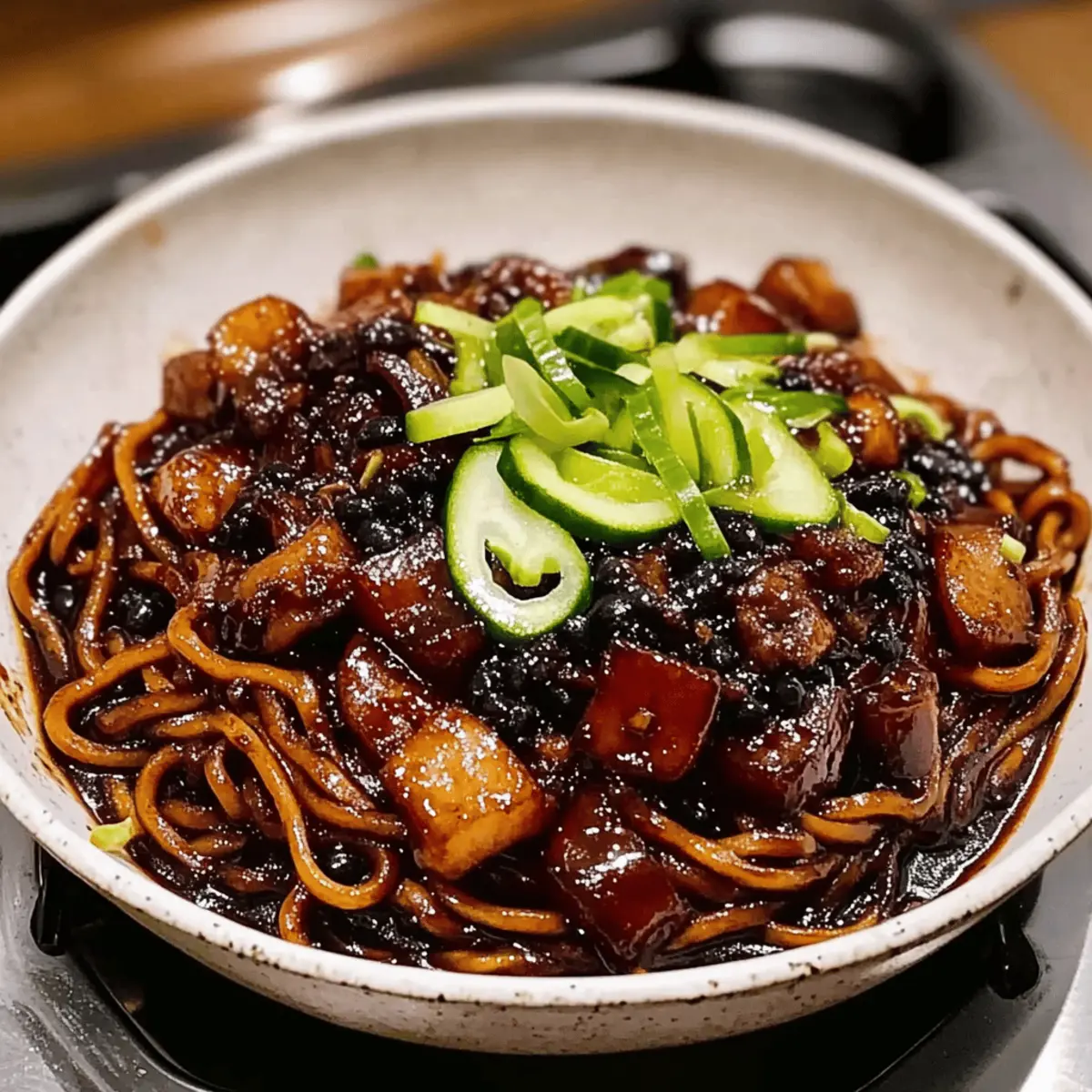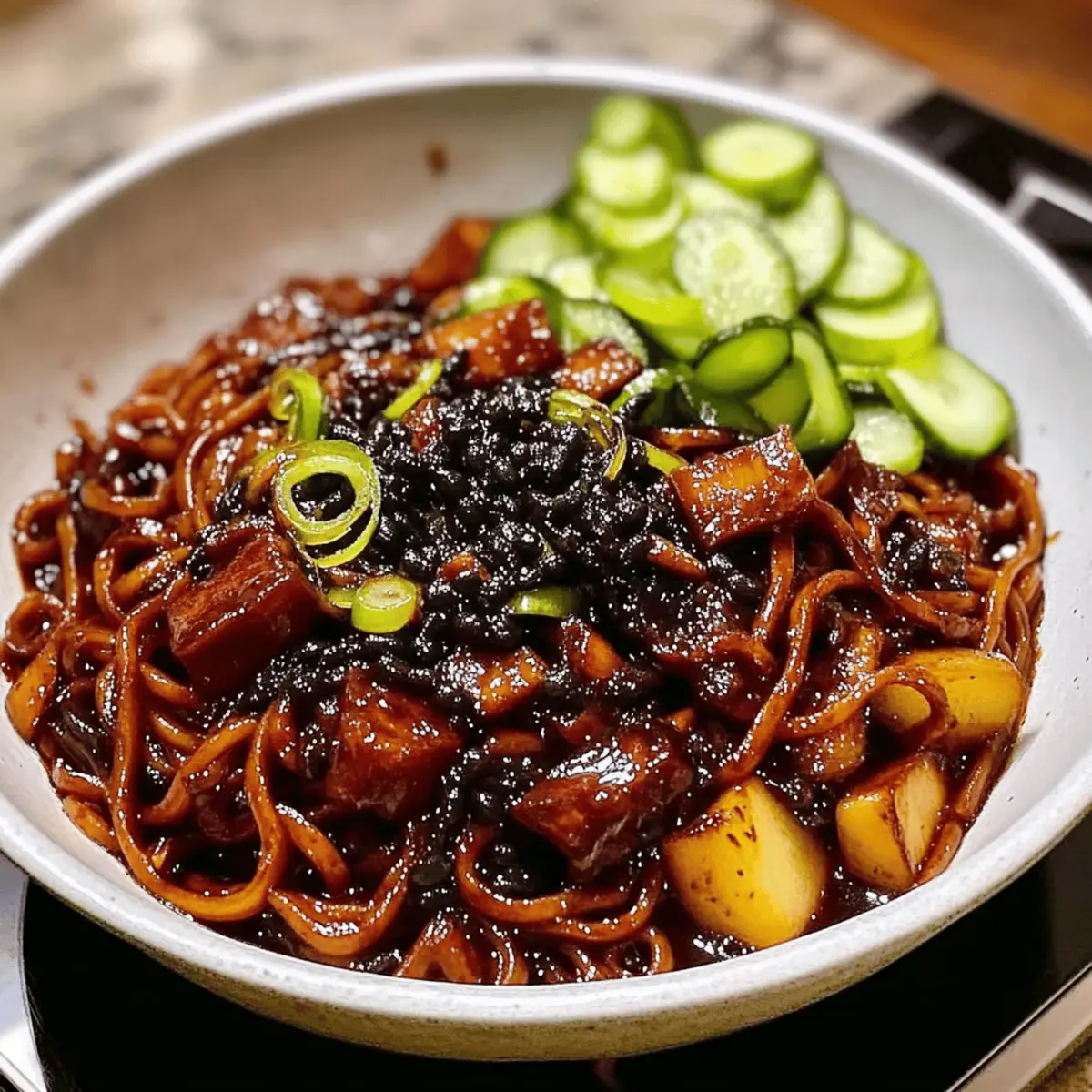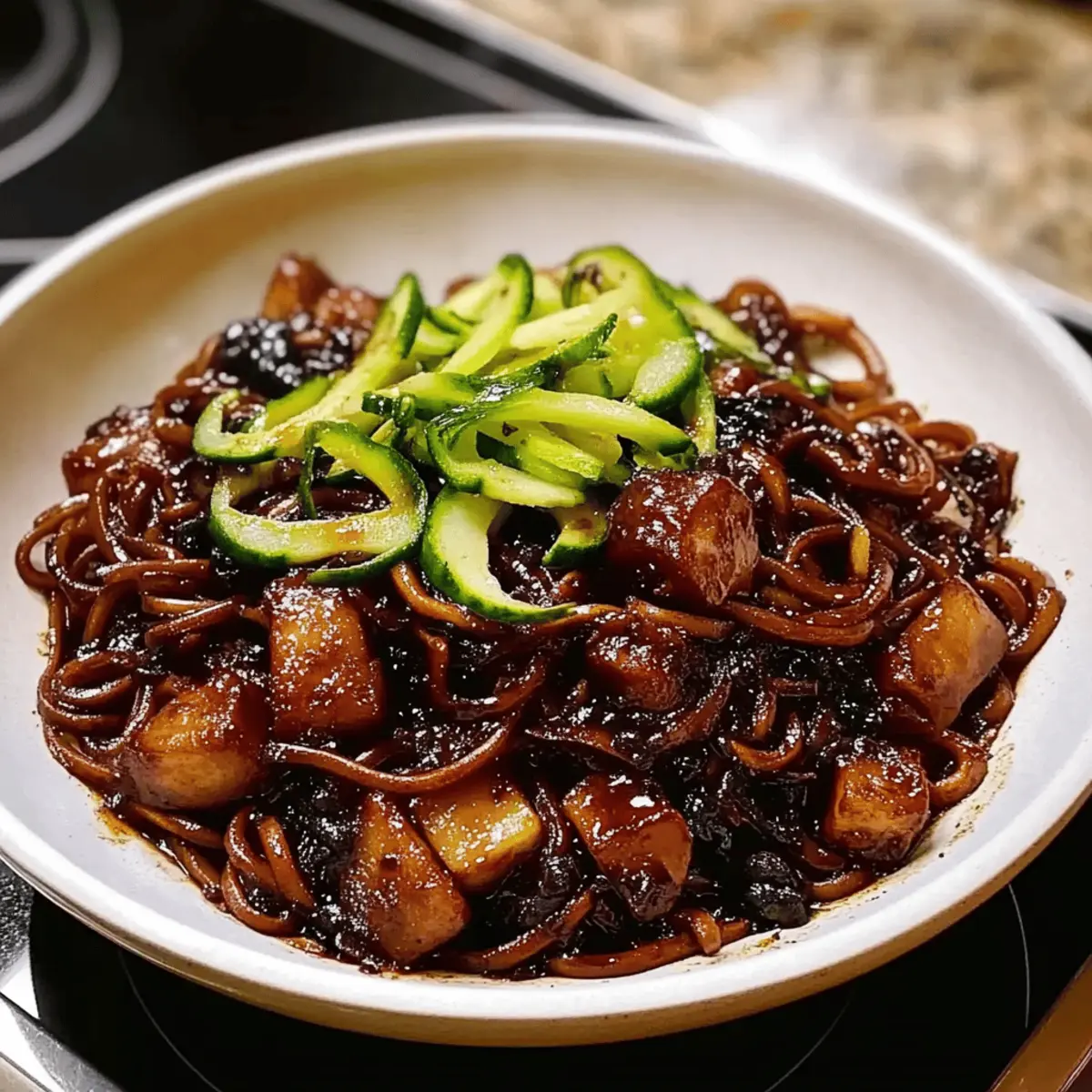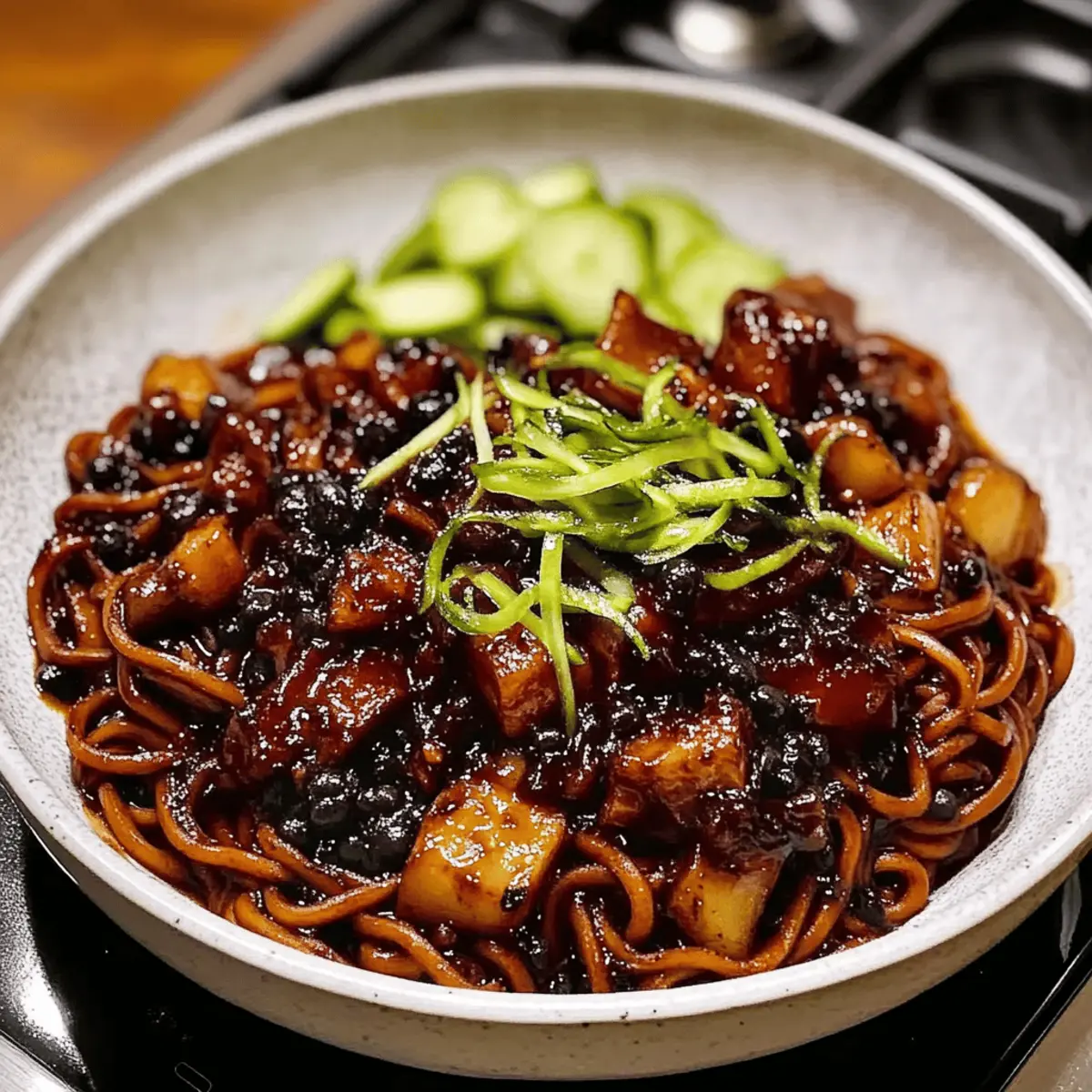The aroma of sizzling pork belly fills the kitchen, instantly transporting me to the bustling streets of Seoul. That’s the magic of making Jajangmyeon (Korean Black Bean Noodles) at home—a comforting dish that warms both the body and soul. This recipe combines tender noodles with a rich, savory black bean sauce that envelops crispy pork and fresh veggies, creating an experience that feels indulgent yet surprisingly easy to prepare. What I love most about Jajangmyeon is its adaptability; whether you prefer a vegetarian twist or gluten-free noodles, it’s a crowd-pleaser that invites everyone to the table. With quick prep time and satisfying flavors, this dish is perfect for busy weeknights or special occasions. Are you ready to explore the depths of this comforting classic? Let’s dive in!

Why is Jajangmyeon So Beloved?
Simplicity Made Delicious: Jajangmyeon’s straightforward ingredients and prep mean you can whip up this dish even on your busiest days.
Rich Umami Flavor: The signature black bean sauce, combined with crispy pork or mushrooms, delivers layers of depth that will tantalize your taste buds.
Versatile and Adaptable: Customize your Jajangmyeon with seafood, vegetarian substitutes, or gluten-free noodles, making it a dish everyone can enjoy.
Comfort Food at Its Finest: This Korean classic is a comforting bowl of happiness, perfect for cozy nights or special gatherings.
Quick and Easy Prep: In just 30 minutes, you can savor a home-cooked meal that’s far better than any fast food option.
Elevate your dining experience by pairing it with some deliciously crunchy pickled radish or kimchi, and don’t forget to check out our Pot Pinto Beans for another cozy recipe to try!
Jajangmyeon Ingredients
Discover the essential components for making delicious Jajangmyeon!
For the Sauce & Protein
- Vegetable Oil – Used for sautéing; sesame oil can add a nutty flavor.
- Pork Belly – Base protein that lends richness; tofu or mushrooms can be used for a vegetarian option.
- Korean Black Bean Paste (Chunjang) – The key ingredient for umami; sauté before adding to enhance flavor.
- Sugar – Balances bitterness; honey can be a great substitute.
- Oyster Sauce – Adds savoriness; soy sauce works for vegetarian versions.
For the Vegetables
- Onion – Provides natural sweetness; yellow or white onions are best.
- Zucchini – Adds moisture; bell pepper or carrots can be substituted.
- Potato – Essential for heartiness; sweet potatoes offer a delightful sweetness.
- Garlic – Amplifies flavors; freshly minced is ideal.
For the Noodles
- Fresh Jajangmyeon Noodles – Best for texture; thick wheat or gluten-free noodles are fine alternatives.
- Cornstarch – Thickens the sauce; can be replaced with all-purpose flour.
For the Garnish
- Julienne Cucumber – Optional, it adds a refreshing crunch to balance the rich sauce.
Gather these ingredients to create your comforting bowl of Jajangmyeon (Korean Black Bean Noodles) that your whole family will love!
Step‑by‑Step Instructions for Jajangmyeon (Korean Black Bean Noodles)
Step 1: Sauté the Pork Belly
In a large pan, heat 2 tablespoons of vegetable oil over medium-high heat. Once hot, add diced pork belly and cook for about 5 minutes, stirring often, until it turns golden brown and crispy. The enticing aroma will fill your kitchen, ensuring you’re ready for the next steps in making Jajangmyeon.
Step 2: Cook the Vegetables
Add 1 chopped onion, 1 diced zucchini, and 1 diced potato to the pan with the pork. Sauté everything together for 5-7 minutes, stirring occasionally, until the vegetables soften and the onion turns translucent. The vibrant colors signal that your base is coming together beautifully for the Jajangmyeon.
Step 3: Add Garlic
Stir in 2 minced garlic cloves into the pan and cook for an additional minute, stirring constantly. This will infuse your mixture with rich flavor and aroma. Make sure not to let the garlic burn—just until fragrant before moving on to build the sauce.
Step 4: Incorporate Black Bean Paste
Next, scoop in 4 tablespoons of Korean black bean paste (chunjang) along with 1 tablespoon of sugar. Mix well until the pork and vegetables are thoroughly coated in the dark, glossy paste. Sauté for another 2-3 minutes, allowing the flavors to enhance and the bitterness of the paste to mellow.
Step 5: Add Sauces and Simmer
Pour in 2 tablespoons of oyster sauce and 1 cup of water, stirring the mixture until everything is fully combined. Bring the sauce to a gentle simmer, covering the pan with a lid. Let it cook for 8-10 minutes, allowing the vegetables to become fork-tender, which adds depth to your Jajangmyeon sauce.
Step 6: Thicken the Sauce
In a small bowl, mix 1 tablespoon of cornstarch with 2 tablespoons of water to create a slurry. Once the sauce has simmered, stir in this mixture and cook for an additional 2 minutes until the sauce thickens. You’ll know it’s ready when it clings to the back of a spoon, providing that rich texture for your dish.
Step 7: Prepare the Noodles
While your sauce is thickening, cook 300 grams of fresh Jajangmyeon noodles according to the package instructions, usually about 3-5 minutes in boiling water. Once cooked, drain and rinse the noodles in cold water to stop the cooking process, ensuring they stay chewy and ready to absorb the savory sauce.
Step 8: Serve Your Jajangmyeon
To assemble, place a generous portion of noodles into serving bowls, and spoon the hot black bean sauce with pork and vegetables on top. If desired, garnish with julienned cucumber for a crunchy, fresh contrast. Your delightful bowl of Jajangmyeon (Korean Black Bean Noodles) is now ready to savor!

Expert Tips for Jajangmyeon
-
Sauté It Right: Always sauté the chunjang black bean paste to reduce bitterness. This step enhances the umami flavor in your Jajangmyeon.
-
Choose Fresh Noodles: Opt for fresh Jajangmyeon noodles for the best texture. If using dried noodles, be sure to adjust cooking time accordingly.
-
Balance Sweetness: Adjust the sweetness of the sauce by experimenting with sugar or oyster sauce. Taste as you go to find your perfect balance!
-
Avoid Overcooking: Keep an eye on your vegetables. Cook them until fork-tender but not mushy to maintain a delightful contrast in textures.
-
Perfect Portioning: For an easy serving experience, consider plating the noodles and sauce separately, allowing each person to mix as they like.
-
Warm Garnish: Serve with julienned cucumber at room temperature, as it adds a refreshing crunch that compliments the rich sauce beautifully.
Make Ahead Options
These Jajangmyeon (Korean Black Bean Noodles) are perfect for meal prep, making busy weeknights a breeze! You can prepare the black bean sauce with pork and vegetables up to 3 days in advance and store it in an airtight container in the refrigerator. To maintain the sauce’s rich consistency, slightly undercook the vegetables so they don’t become mushy during storage. When you’re ready to serve, simply reheat the sauce on the stovetop, cook the noodles according to package instructions, and then combine. This way, you’ll enjoy the same delicious, comforting flavors with minimal effort, ideal for a quick yet satisfying dinner!
What to Serve with Jajangmyeon (Korean Black Bean Noodles)
Elevate your Jajangmyeon experience by pairing it with delicious side dishes and drinks that complement its rich flavors.
-
Pickled Radish (Danmuji):
The bright, tangy crunch of pickled radish cuts through the richness of Jajangmyeon, enhancing each bite with a refreshing contrast. -
Kimchi:
A staple in Korean cuisine, the spicy, fermented notes of kimchi bring warmth and flavor that perfectly balance the savory black bean noodles. -
Sesame Spinach Salad:
Light and herbaceous, this salad adds a crisp texture and a nutty flavor that pairs beautifully with the noodles’ depth. -
Korean Fried Chicken:
For a true feast, the crispy coating and savory glaze of fried chicken creates a delightful textural harmony with the chewy noodles. -
Barley Tea:
This warm, slightly nutty drink not only cleanses the palate but also complements the umami of Jajangmyeon beautifully. -
Sweet Potato Fries:
Their natural sweetness and satisfying crunch make a wonderful contrast to the rich, savory black bean sauce, ensuring a comfort food delight. -
Fried Dumplings (Mandu):
These crispy morsels filled with vegetables or meat add a delightful layer of flavor and texture beside steaming bowls of Jajangmyeon. -
Fruity Dessert (e.g., Bingsu):
A light, icy treat topped with fresh fruits offers a refreshing finish to the meal, cleansing the palate after the hearty main dish.
Jajangmyeon Recipe Variations & Substitutions
Feel free to add your personal touch to Jajangmyeon and make it your own masterpiece!
-
Seafood Surprise: Add shrimp or squid to your dish for a delightful twist, enhancing the umami experience.
-
Vegetarian Delight: Swap out the pork belly for tofu or mushrooms, keeping the essence yet appealing to vegetarians.
-
Gluten-Free Option: Use rice noodles or other non-wheat varieties to ensure everyone can enjoy this comforting dish.
-
Extra Crunch: Consider adding some roasted peanuts or crispy shallots on top for a delicious crunch and lovely visual appeal. They can elevate the experience!
-
Spicy Kick: If you’re a spice lover, toss in some gochujang (Korean red chili paste) or a sprinkle of chili flakes to heat things up.
-
Crispy Veggies: Incorporate some sautéed bell peppers or snap peas for added texture and color. They harmonize beautifully with the dish!
-
Flavor Booster: Try adding a dash of sesame oil at the end for a fragrant finish. The nuttiness will linger in your palate happily.
-
Sweet Potato Twist: Replace regular potatoes with sweet potatoes for a sweeter, richer base that adds depth to every bite. Plus, it’s a great way to sneak in some extra nutrition!
And don’t forget, if you’re looking for other comforting dishes to round out your meal, check out our delightful Pot Pinto Beans for a perfect side option!
Storage Tips for Jajangmyeon
Fridge: Store leftover Jajangmyeon in an airtight container for up to 2 days. To maintain flavor and texture, separate the noodles from the sauce if possible.
Freezer: For longer storage, freeze the sauce and cooked noodles separately in airtight containers for up to 2 months. Thaw in the fridge overnight before reheating.
Reheating: To reheat, warm the sauce on the stovetop until bubbling and pliable, then add cooked noodles and mix until heated through. This keeps your Jajangmyeon delicious and satisfying!

Jajangmyeon (Korean Black Bean Noodles) Recipe FAQs
What should I look for in ripe ingredients for Jajangmyeon?
Absolutely! When selecting your vegetables, choose firm, unblemished zucchinis and potatoes with no dark spots. Onions should be dry and heavy for their size, and the garlic should be firm with no sprouting. If you’re using fresh noodles, look for a glossy appearance and a bit of bounce—this ensures they’ll have that delightful chewy texture in your dish.
How do I store leftover Jajangmyeon?
For the best flavor, store leftover Jajangmyeon in an airtight container in the fridge for up to 2 days. If you can, separate the noodles from the sauce; this helps keep the noodles from becoming mushy. Just reheat the sauce gently on the stove before adding the noodles back in!
Can I freeze Jajangmyeon?
Yes, you can freeze Jajangmyeon! For optimal results, freeze the sauce and cooked noodles separately in airtight containers for up to 2 months. Allow the sauce to cool completely before freezing. When you’re ready to enjoy it again, simply thaw in the fridge overnight and reheat the sauce on the stovetop before adding the noodles.
What if my sauce is too thick?
Very common! If your Jajangmyeon sauce turns out too thick, don’t fret. Simply add a little room temperature water while stirring continuously until it reaches your desired consistency. Start with a tablespoon at a time, ensuring you monitor the flavor. If needed, adjust seasonings afterward.
Are there any dietary considerations for Jajangmyeon?
Definitely! Jajangmyeon is highly adaptable. For a gluten-free version, use rice or gluten-free noodles instead of traditional wheat noodles. If you’re preparing a vegetarian dish, swap out the pork for tofu or mushrooms. Also, check the labels on the black bean paste and oyster sauce, as some brands may contain allergens.
How can I ensure my pork belly turns out crispy?
To achieve that perfect crispiness, make sure to properly render the fat from the pork belly. Cook it over medium-high heat without overcrowding the pan for about 5 minutes, allowing it to brown evenly. Don’t forget to keep an eye on it; adjust the heat as needed to avoid burning while ensuring a lovely golden color develops!

Jajangmyeon: Savory Korean Black Bean Noodles for Comfort
Ingredients
Equipment
Method
- Sauté the Pork Belly: In a large pan, heat 2 tablespoons of vegetable oil over medium-high heat. Once hot, add diced pork belly and cook for about 5 minutes, stirring often, until it turns golden brown and crispy.
- Cook the Vegetables: Add 1 chopped onion, 1 diced zucchini, and 1 diced potato to the pan with the pork. Sauté everything together for 5-7 minutes, stirring occasionally, until the vegetables soften.
- Add Garlic: Stir in 2 minced garlic cloves into the pan and cook for an additional minute, stirring constantly.
- Incorporate Black Bean Paste: Next, scoop in 4 tablespoons of Korean black bean paste (chunjang) along with 1 tablespoon of sugar. Mix well until the pork and vegetables are thoroughly coated.
- Add Sauces and Simmer: Pour in 2 tablespoons of oyster sauce and 1 cup of water, stirring until combined. Bring the sauce to a gentle simmer and cover the pan.
- Thicken the Sauce: Mix 1 tablespoon of cornstarch with 2 tablespoons of water to create a slurry. Stir this mixture into the sauce and cook for an additional 2 minutes.
- Prepare the Noodles: Cook 300 grams of fresh Jajangmyeon noodles according to the package instructions, usually about 3-5 minutes. Drain and rinse the noodles.
- Serve Your Jajangmyeon: Place a generous portion of noodles into serving bowls, and spoon the hot black bean sauce with pork and vegetables on top.



